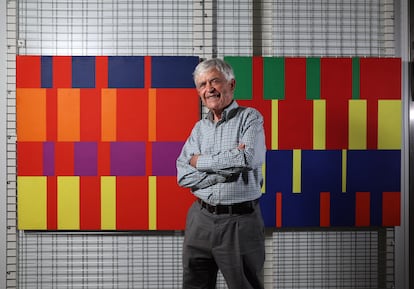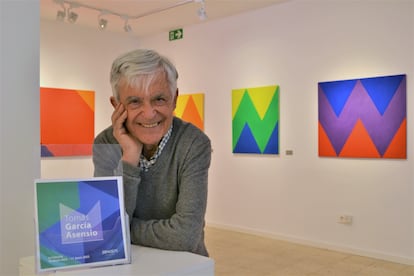The Spanish painter who used a computer to create art half a century before AI
Tomás García Asensio was an early advocate of using technology for artistic creation at a time when computers occupied entire rooms and artificial intelligence was a far-off concept

The use of generative artificial intelligence (AI) to create stunning images from text prompts has seemingly captivated the world. However, the popularity of tools like Dall-E and Midjourney has alarmed some of the art world. For months, people have voiced concerns over the implications of this technology. But 50 years ago, artists were already dabbling in computers before the technology attained the perfection we see today. One of the most remarkable experiments happened in Spain and produced an unprecedented union of art and technology.
On March 7, 1969, a few months before mankind first set foot on the moon, the University of Madrid (now the Complutense University of Madrid) officially inaugurated its Computing Center, one of the first computer science centers in Spain. A group of multifaceted experts there began exploring the synergies between technology and other fields, like the fine arts. A painter named Tomás García Asensio was one of the artists invited to collaborate in a historic project that can still teach us something five decades later.
“Back then, it seemed to me that computers could be an excellent tool for producing art. I believed that the computer could precisely capture the essence of the color spectrum and seamlessly integrate it into artistic expression,” says García, a forerunner of Spanish geometric constructivism. His experiments with computers produced two works that are now exhibited at the Reina Sofía Museum in Madrid. Now 83, he continues to experiment with color and his latest works can be seen at Espacio75 art gallery in Madrid until June 25.
Of course, computers of that era were a far cry from the ones we have today. To create the Computing Center, the University of Madrid constructed a building (now the UCM Data Processing Center), while IBM supplied the computer equipment. The star of the Computing Center was an IBM 7090 computer, a “general purpose data processing system… designed with special attention to the needs of engineers and scientists, who find computation demands increasing rapidly.” It had magnetic tape drives, printers, card punchers and readers — huge ones, of course.

“It was nothing like the computers we have now. The biggest difference was the total disconnect between the user and the computer. There was no keyboard, no mouse, no images of any kind, other than what you could draw with a Rotring pen plotter. You programmed instructions on perforated cards and then printed the results on very long sheets of paper,” says García. The project participants — visual artists, musicians, architects and poets — worked hand in hand with computer scientists, engineers and mathematicians. “The scientists there had a special insight with respect to art that I had never seen,” he adds.
Florentino Briones was the project director and Mario Fernández Barberá, an IBM employee, was the project coordinator. “Fernández was a collector of contemporary art, so he knew many artists. These seminars served as a prelude to what was to come. Keep in mind, Spain’s interaction with the world was limited due to the dictatorship, which led to a sense of isolation,” says Lola Hinojosa, head of the performance and mixed-media art collection at the Reina Sofía Museum.
The project in Spain paralleled developments in the United States, Germany, and the United Kingdom, where people were creating works at the intersection of art, technology, and science. “García participated in projects and seminars that were cutting-edge not only in Spain, but also across Europe and worldwide — it was a unique artistic and intellectual opportunity,” says Hinojosa. Those efforts influenced García’s later work, as well as many other painters like Manuel Barbadillo, the first Spanish artist to use a computer in his work.
Full-color calculations and algorithms
“The colors are still very vivid,” exclaims García happily as he looks at the two paintings he created in 1970 at the Computing Center. He’s a mathematical artist who explored color combinations and relationships using a giant computer 53 years ago. His concept was to paint a picture with a computer by manipulating the connection between luminance and size, and developing a mathematical means of incorporating color into the piece. While explaining his approach, García tosses out a word very much in vogue today — algorithm.

“Back then, I viewed computers as very powerful calculators, and I still do. I was interested in color combinations, so I devised a system to generate them. It was like a math game using a computer,” he says. To accomplish this, he envisioned two spectrums, one ranging from the lightest color of yellow to the darkest of blue. Between these bookends, he created a range of intermediates, including both a direct spectrum of greens and turquoise, and an indirect range including reds and oranges. The luminosity correlation between these colors was used to attribute relationships and proportions.
García “fed the computer,” as he says, and played with “the distribution of interpolated series, both increasing and decreasing, to determine the size of chromatic areas relative to the color qualities.” The designs were produced by the computer and then painted traditionally. García believes that science and art are not mutually exclusive — some mathematical expressions are simply beautiful.
Numerous works in which computers played an essential role were produced at the Computing Center, and many are exhibited in Room 430 at the Reina Sofía Museum. García’s pieces are typically showcased in a separate section of the museum, among other works he created during his residency at the University of Puerto Rico in Mayagüez.

García and fellow artists didn’t have to learn computer programming for the project, but they relished the intellectual exchange that influenced their work and inspired a rethinking of art. “García was one of the most active artists at the Computing Center. Without a doubt, his works are exemplary of the theoretical and production aspects of that experience,” said Hinojosa.
Five decades have passed and computers have developed exponentially, but “the paintings look like they were made yesterday — they haven’t aged a bit. It’s fascinating that they were created at a time when it was very hard to be different, yet this amazing, collaborative movement happened,” says Gema Guaylupo, co-founder and artistic director of Espacio75.
Informatics in support of AI
Unlike figurative art, which represents recognizable figures, García uses geometry in his paintings to avoid real-life representation and play with abstract colors. “A lie that appears more genuine is, in fact, a greater deception. Paintings that don’t represent anything are real,” he says. This thought reminds us of the AI-driven programs that generate increasingly realistic images. In March, Midjourney V5 (an AI-driven illustration program) was released, enabling lies (in García’s words) that are very difficult to distinguish from reality.

“Even though computers in the 1970s had limited capacity, you could still program equations and create drawings and patterns that would be very difficult to do by hand. We are living in a vastly different era today — computers have transcended their purely mechanical and algorithmic origins to more closely resemble us,” says Álvaro Barbero, director of artificial intelligence at Spain’s Institute for Knowledge Engineering (IIC). AI has transformed the landscape and no longer are mathematical formulas the sole basis for computer programs. Now they are designed to learn from other images, “generating something that looks just like a person’s hand-drawn creations,” adds Barbero, who researches AI-based image generation.
The phrase “artificial intelligence” was coined in 1956. When AI tools capable of creating images became widely available in 2022, a debate about computers ignited that is very different from the experiments at the Computing Center. “Back then, it [a computer] was a supplement. Today, what Dall-E and Midjourney can do in a way supplants an artist’s traditional techniques,” says Barbero. But the IIC expert believes that the key is to continue seeing technology as a tool, just like García and the other artists at the Computing Center. “You can provide an AI tool with a concept or idea and ask it to generate a variety of versions that can be used as a starting point for artists to explore their vision.”
Lola Hinojosa says dismissing current technology tools would be a loss. “Throughout history, artists have embraced emerging technologies, from primitive cave paintings to contemporary techniques. In my opinion, the important thing is to openly disclose the technology being used.”
What do those Spanish pioneers of integrating technology and art think? García also believes ignoring these new tools would be a lost opportunity, because “with a machine you can use data to attain a certain precision that is impossible with the eye alone.” Despite his reluctance to embrace the term “artificial intelligence,” he envisions a great future. “Although I have doubts about the intelligence of machines, I believe that when combined with human intelligence, the possibilities are fascinating and limitless.” In the meantime, he will keep on painting in full color.
The photographs provided by Tomás García Asensio appear in ‘Catalog of the computer-assisted art exhibition held in Madrid in the Palacio Nacional de Congresos on the occasion of the European Systems Engineering Symposium’ (University of Madrid Computing Center, 1971).
Sign up for our weekly newsletter to get more English-language news coverage from EL PAÍS USA Edition
Tu suscripción se está usando en otro dispositivo
¿Quieres añadir otro usuario a tu suscripción?
Si continúas leyendo en este dispositivo, no se podrá leer en el otro.
FlechaTu suscripción se está usando en otro dispositivo y solo puedes acceder a EL PAÍS desde un dispositivo a la vez.
Si quieres compartir tu cuenta, cambia tu suscripción a la modalidad Premium, así podrás añadir otro usuario. Cada uno accederá con su propia cuenta de email, lo que os permitirá personalizar vuestra experiencia en EL PAÍS.
¿Tienes una suscripción de empresa? Accede aquí para contratar más cuentas.
En el caso de no saber quién está usando tu cuenta, te recomendamos cambiar tu contraseña aquí.
Si decides continuar compartiendo tu cuenta, este mensaje se mostrará en tu dispositivo y en el de la otra persona que está usando tu cuenta de forma indefinida, afectando a tu experiencia de lectura. Puedes consultar aquí los términos y condiciones de la suscripción digital.
More information
Archived In
Últimas noticias
Human rights activists, opposition members, and a minor: Maduro’s other political prisoners
Israel sparks a civil war within the MAGA movement
The complicated life of Francesca Albanese: A rising figure in Italy but barred from every bank by Trump’s sanctions
Pinochet’s victims grapple with José Antonio Kast’s rise in Chile
Most viewed
- Reinhard Genzel, Nobel laureate in physics: ‘One-minute videos will never give you the truth’
- Pablo Escobar’s hippos: A serious environmental problem, 40 years on
- Charles Dubouloz, mountaineering star, retires at 36 with a farewell tour inspired by Walter Bonatti
- Why we lost the habit of sleeping in two segments and how that changed our sense of time
- The Florida Keys tourist paradise is besieged by immigration agents: ‘We’ve never seen anything like this’










































